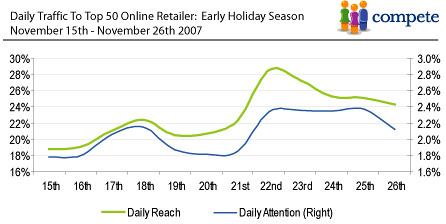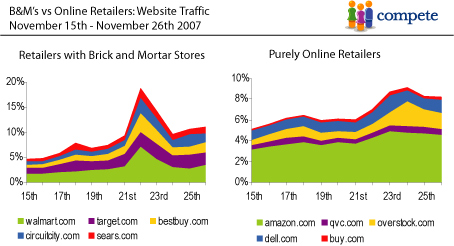It's time to stick a fork in the notion of "Cyber Monday." In terms of traffic, there's no doubt that the holiday season represents a period of peak activity for retailers of all shapes, sizes and online penetration, but idea that a bevy of internet users will start frantically clicking the "add to cart" button on the Monday after Thanksgiving is just wrong. However, the weeks leading up to cyber Monday gives a really interesting perspective on how people use the web to shop.
The chart below shows the retail sector's daily reach* and daily attention** from the 15th to the 26th of November, for a set of the top 50 online retailers in the U.S.

By considering both total visitors (Daily Reach) and total time (Daily Attention), it's possible to expose any high-level changes in actual shopping behavior.
- There is a significant ramp up in both Attention and Reach from the period of November 15th through the 23rd, before both begin to trail off. On Thanksgiving, nearly 30% of every U.S internet browser visited one of the top 50 online retailers.
- A widening gap begins to develop between the two metrics on the 18th, indicating that visitors are spending less time per visit at retailers. A major factor in this could be related to research (more on this later).
- Interestingly, while Daily Reach peaks on the 22rd, Attention remains stable through the 25th indicating a trend of more involved site visitors on the 25 and 26th. Strangely, on "the biggest online shopping day of the year" Attention falls dramatically.
Debating whether to sleep outside Bestbuy or Walmart
Almost every brick and mortar store offers some sort of "Door Buster" deals on Black Friday, and for some crazy reason, people are willing to hang out in the freezing cold for 10 hours to save $50 on an mp3 player…go figure.
But the internet is now heavily immersed in consumer shopping, if only to point people in the direction of the biggest sale. The table below shows Daily Reach to two sets of sites: the top 5 online retailers (in terms of site traffic) that have a network of physical stores, and the top 5 online retailers who have litter or no offline presence.

While both groups show dramatic growth during a the 11 day period (nearly 100% for both groups from start to finish) they have dramatically different growth trends.
- Top retailers with physical stores experienced an over 100% growth in Daily Reach between November 21st and 22nd.Given the dramatic spike, it appears that almost all of these incremental visitors were researching in-store "Black Friday" deals and not actually shopping for goods online.
- In contrast, retailers with a predominately internet based model saw steady growth, actually peaking on the 24th (the day after Black Friday). This could likely be related to shoppers missing deals at offline retailers, and turning to the internet to look for savings, a theory substantiated by the spike in traffic to Overstock.com.
Given the way people are using the internet for holiday shopping, does it make sense for the solely online stores to compete with their offline brethren? I know if Amazon had offered a select few of it's "Customer vote" items at 5:00 in the morning I would have stayed home for it…okay I stayed home anyway, but at least I would have rolled out of bed.
* Daily Reach is defined as the total number of visitors to a domain as a percentage of all unique U.S internet users on a specific day.
** Daily Attention is defined as the total time spent on a domain as a percentage of the total time spent online by all U.S. internet users on a specific day.
Source: Blog compete

No comments:
Post a Comment